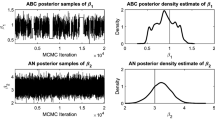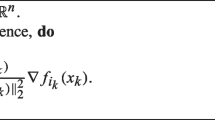Abstract
A key feature of the analysis of three-way arrays by Candecomp/Parafac is the essential uniqueness of the trilinear decomposition. We examine the uniqueness of the Candecomp/Parafac and Indscal decompositions. In the latter, the array to be decomposed has symmetric slices. We consider the case where two component matrices are randomly sampled from a continuous distribution, and the third component matrix has full column rank. In this context, we obtain almost sure sufficient uniqueness conditions for the Candecomp/Parafac and Indscal models separately, involving only the order of the three-way array and the number of components in the decomposition. Both uniqueness conditions are closer to necessity than the classical uniqueness condition by Kruskal.
Similar content being viewed by others
References
Carroll, J.D., & Chang, J.J. (1970). Analysis of individual differences in multidimensional scaling via an n-way generalization of Eckart–Young decomposition. Psychometrika, 35, 283–319.
Fisher, F.M. (1966). The identification problem in econometrics. New York: McGraw-Hill.
Harshman, R.A. (1970). Foundations of the Parafac procedure: Models and conditions for an “explanatory“ multimodal factor analysis. UCLA Working Papers in Phonetics, 16, 1–84.
Harshman, R.A. (1972). Determination and proof of minimum uniqueness conditions for Parafac–1. UCLA Working Papers in Phonetics, 22, 111–117.
Jiang, T., & Sidiropoulos, N.D. (2004). Kruskal's permutation lemma and the identification of Candecomp/Parafac and bilinear models with constant modulus constraints. IEEE Transactions on Signal Processing, 52, 2625–2636.
Kruskal, J.B. (1977). Three-way arrays: Rank and uniqueness of trilinear decompositions, with applications to arithmetic complexity and statistics. Linear Algebra and its Applications, 18, 95–138.
Kruskal, J.B., Harshman, R.A., & Lundy, M.E. (1989). How 3-MFA data can cause degenerate Parafac solutions, among other relationships. In: R. Coppi, & S. Bolasco (Eds.), Multiway data analysis (pp. 115–121). Amsterdam: North-Holland
De Lathauwer, L. (2006). A link between the canonical decomposition in multilinear algebra and simultaneous matrix diagonalization. SIAM Journal of Matrix Analysis and Application, to appear.
Leurgans, S.E., Ross, R.T., & Abel, R.B. (1993). A decomposition for three-way arrays. SIAM Journal on Matrix Analysis and Applications, 14, 1064–1083.
Sidiropoulos, N.D., & Bro, R. (2000). On the uniqueness of multilinear decomposition of n-way arrays. Journal of Chemometrics, 14, 229–239.
Stegeman, A., & Ten Berge, J.M.F. (2006). Kruskal's condition for uniqueness in Candecomp/Parafac when ranks and k-ranks coincide. Computational Statistics and Data Analysis, 50, 210–220.
Ten Berge, J.M.F., & Sidiropoulos, N.D. (2002). On uniqueness in Candecomp/Parafac. Psychometrika, 67, 399–409.
Ten Berge, J.M.F., Sidiropoulos, N.D., & Rocci, R. (2004). Typical rank and Indscal dimensionality for symmetric three-way arrays of order I×2×2 or I×3×3. Linear Algebra and Applications, 388, 363–377.
Author information
Authors and Affiliations
Corresponding author
Additional information
Part of this research was supported by (1) the Flemish Government: (a) Research Council K.U. Leuven: GOA-MEFISTO-666, GOA-Ambiorics, (b) F.W.O. project G.0240.99, (c) F.W.O. Research Communities ICCoS and ANMMM, (d) Tournesol project T2004.13; and (2) the Belgian Federal Science Policy Office: IUAP P5/22. Lieven De Lathauwer holds a permanent research position with the French Centre National de la Recherche Scientifique (C.N.R.S.). He also holds an honorary research position with the K.U. Leuven, Leuven, Belgium.
Rights and permissions
About this article
Cite this article
Stegeman, A., Berge, J.M.F.T. & Lathauwer, L.D. Sufficient conditions for uniqueness in Candecomp/Parafac and Indscal with random component matrices. Psychometrika 71, 219–229 (2006). https://doi.org/10.1007/s11336-006-1278-2
Received:
Accepted:
Published:
Issue Date:
DOI: https://doi.org/10.1007/s11336-006-1278-2




